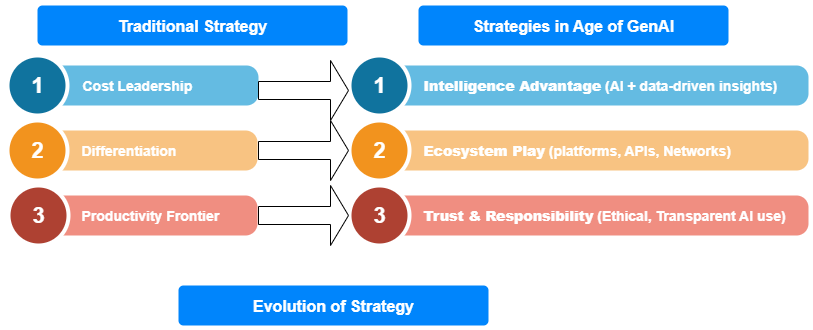For decades, business leaders relied on tried-and-tested strategy frameworks to gain an edge. Michael Porter’s ideas of Cost Leadership, Differentiation, and the Productivity Frontier dominated boardroom discussions and MBA classrooms alike.
I can’t recall an MBA class that didn’t include a discussion on Porter’s Five Forces.
These strategies thrived in a world where competition moved in predictable cycles, technology adoption was slower, and market moats could last for decades.
But today, we are in a radically different environment. The rise of Generative AI (GenAI) and data-driven ecosystems has rewritten the rules of the game. What once worked as a sustainable advantage now feels like table stakes.
Why Traditional Strategies Are Losing Their Power
1. Cost Leadership Is Commoditized
-
Automation and AI have dramatically reduced operational costs for everyone.
-
Competing purely on price no longer builds a defensible edge, because competitors can deploy similar tools at scale.
2. Differentiation Is Harder to Sustain
-
Unique features or offerings can be rapidly replicated with AI-enabled design, personalization, and content generation.
-
What used to take years to imitate can now be cloned in weeks—or even days.
3. The Productivity Frontier Has Shifted
-
Historically, firms faced a trade-off between cost and quality.
-
AI has broken that trade-off by enabling both hyper-efficiency and hyper-personalization at the same time.
In short, the old rules no longer guarantee advantage.
What’s Replacing Traditional Strategy?
As GenAI reshapes industries, new forms of advantage are emerging. Here are three that matter most:
1. Intelligence Advantage
-
Competing on how well you harness AI + data for decision-making, customer experiences, and innovation.
-
Example: Amazon using AI for anticipatory logistics, predicting what customers will want before they even order.
2. Ecosystem Play
-
Winning by orchestrating platforms, APIs, and partnerships instead of going it alone.
-
Example: OpenAI and Microsoft’s Copilot ecosystem, where integration creates exponential value beyond standalone tools.
3. Trust & Responsible AI
-
In a world concerned about bias, security, and transparency, trust becomes a differentiator.
-
Customers, regulators, and partners will prefer companies that deploy AI responsibly and ethically.
The New Strategic Mindset
To succeed in the Age of GenAI, leaders must rethink strategy as a living system, not a static plan.
-
From Efficiency → Learning: Compete on how fast you can learn from data and adapt.
-
From Products → Experiences: Move beyond features to deliver hyper-personalized, AI-powered experiences.
-
From Moats → Networks: Build defensibility through data ecosystems, partnerships, and network effects—not just cost structures.
A Framework for Strategy in the GenAI Era

This shift illustrates that traditional strategy hasn’t vanished—it has evolved. The new frontier is built on adaptability, intelligence, and trust.
Conclusion
The companies that will win in the coming decade are not those that simply cut costs or add features. They are the ones that:
-
Learn faster than their competitors.
-
Build ecosystems that scale value.
-
Earn trust by deploying AI responsibly.
Strategy in the Age of GenAI is not about choosing between cost or differentiation—it’s about becoming adaptive, intelligent, and trustworthy at scale.
The future belongs to leaders who embrace this shift, not as a challenge, but as an opportunity to reimagine what competitive advantage truly means.
The future belongs to those who can think strategically in real-time, powered by AI and data, while maintaining the human insight and ethical judgment that makes strategy truly effective.
What soft skills have been most valuable in your leadership journey? Share your thoughts below.